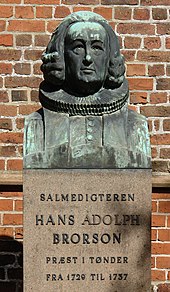Hans Adolph Brorson
Hans Adolph Brorson (born June 20, 1694 in Randerup , † June 3, 1764 in Ribe ) was a Danish bishop and one of the greatest hymn poets in Scandinavia .
Life
Brorson attended high school in Ribe until 1712 and then studied Protestant theology at the University of Copenhagen . After four years, however, he interrupted his studies and moved to Løgumkloster in Southern Jutland , where he worked as a tutor in the following years. In Løgumkloster Brorson got to know the pietism coming from Germany , which deeply impressed him. He then resumed his studies in Copenhagen in 1721 and, after successfully completing his degree, took up a pastor's position in Randerup in 1722 . Between 1729 and 1735 he worked as a pastor at the Kristkirke in Tønder. From 1721 he began to write his first poems and songs. In addition, Brorson devoted himself to the translation of songs from the German Baroque and German Pietism into Danish. The 1739 published Songbook Troens rare Klenodie (about: Of Faith beautiful gem ) contains 82 original seals and 192 translations. In 1737 he came to Ribe as provost . In 1741 he was finally elected Bishop of Ribe, an office he held until his death in 1764. Four years before his death he published the treatise De Vexillo Ecclesiæ , written in Latin , in which he clearly opposed the rationalism propagated by the Enlightenment , which was increasingly gaining ground in Scandinavia. After his death, his sons found 70 unpublished songs from the last years of his life, which were published in 1765 under the title Svane-Sang (Swan Song ).
Brorson was married twice. With his first wife, his cousin Cathrine Stenbek Clausen, Brorson had 13 children, but seven of them died. A child was born paralyzed and mentally handicapped and was kept in a chamber for life. After the death of his first wife in June 1741, he married Johanne Christine Riese on June 29, 1742, with whom he had three more children.
While Brorson's Pietistic songs were increasingly forgotten after his death, they were rediscovered in the 19th century under the influence of new Christian revival movements . The songs from Svane-Sang and from Troens rare Klenodie were summarized in the 19th century in Brorsons Salmebog , which experienced several editions. Today Brorson is represented with numerous songs and song translations in the hymn books of the Danish national church and in Højskolesangbog .
Even today sound from the chimes of the cathedral in Ribe every day at 8 and 18 pm, the sounds of Brorsons hymn The loveliest rose is found .
literature
- Hans Adolph Brorson . In: Carl Frederik Bricka (Ed.): Dansk biografisk Lexikon. Tillige omfattende Norge for Tidsrummet 1537-1814. 1st edition. tape 3 : Brandt – Clavus . Gyldendalske Boghandels Forlag, Copenhagen 1889, p. 126 (Danish, runeberg.org ).
Web links
- Brorson's hymns in the Arkiv for Dansk Litteratur
- via Brorson Den Danske Salmebog online
| personal data | |
|---|---|
| SURNAME | Brorson, Hans Adolph |
| BRIEF DESCRIPTION | Danish bishop and one of the greatest songwriters in Scandinavia |
| DATE OF BIRTH | June 20, 1694 |
| PLACE OF BIRTH | Randerup |
| DATE OF DEATH | June 3, 1764 |
| Place of death | Ribe |

